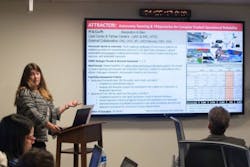NASA announces investments in three unmanned aircraft systems projects
NASAhas announced that three teams of researcherswill each begin separate formal feasibility studies related in unmanned aircraft systems (UAS) as part of NASA’s Convergent Aeronautics Solutions (CAS) project.
The three investigations are expected to take between 24 and 30 months to complete.
"Our idea is to invest a very modest amount of time and money into new technologies that are ambitious and potentially transformative," said Richard Barhydt, NASA’s acting director of the Transformative Aeronautics Concepts Program (TACP). "They may or may not work, but we won’t know unless we try."
The first study aims to develop autonomy-enabling algorithms that will “lay a foundation for establishing justifiable confidence in machine decisions and, ultimately, lead to certification of autonomous systems.” The second study will focus on developing new methods and technologies for a remotely-piloted drone to make sure it is structurally and mechanically sound, and that all its onboard systems have not been damaged or hacked in some way, before each flight.
Lastly, the third study aims to use quantum computing and communication technology to build a secure and jam-free network capable of accommodating hundreds of thousands of drones flying each day, with the idea here being that quantum computers may be able to solve certain problems in a few days that would take millions of years on the average computer.
These studies were selected by a team of NASA aeronautics managers and join five that were selected in 2016and six that were selected in 2015. To be considered, research teams had to form on their own, represent multidisciplinary talents, and have members from more than one of NASA's aeronautics centers in Virginia, California and Ohio.
Pictured: Principal investigators Natalia Alexandrov and Danette Allen make the pitch to a group of NASA aeronautics managers for their team’s study, ATTRACTOR, which will explore how to embed reliability into algorithms that are used over time to inform autonomous systems in aviation. Credits: NASA/Andrew Carlsen
View more information on the NASA research.
Share your vision-related news by contacting James Carroll, Senior Web Editor, Vision Systems Design
To receive news like this in your inbox, click here.
Join our LinkedIn group | Like us on Facebook | Follow us on Twitter
Learn more: search the Vision Systems Design Buyer's Guide for companies, new products, press releases, and videos
About the Author

James Carroll
Former VSD Editor James Carroll joined the team 2013. Carroll covered machine vision and imaging from numerous angles, including application stories, industry news, market updates, and new products. In addition to writing and editing articles, Carroll managed the Innovators Awards program and webcasts.
